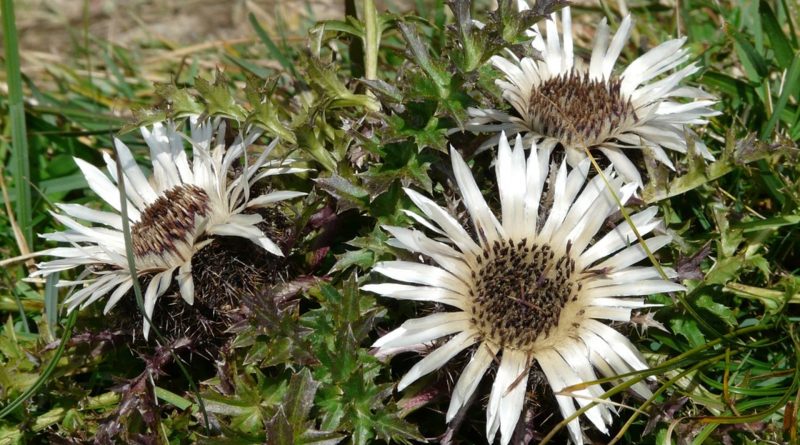Carlina acaulis
Carlina acaulis
The Stemless carline thistle (Carlina acaulis L. 1753) is a perennial herbaceous species, with large white inflorescences, of the Asteraceae family.
Systematics –
This species from the systematic point of view belongs to the Eukaryota Domain, Kingdom Plantae, Spermatophyta Superdivision, Magnoliophyta Division, Magnoliopsida Class, Sottoclasse Asteridae, Asterales Order, Asteraceae Family, Subfamily Cichorioideae, Tribu Cardueae, Sottotribù Carduinae and then to the Genus Carlina and to the Species C acaulis.
Etymology –
The generic term, which was proposed in the fourteenth century by the Aretine botanist Andrea Cesalpino, is somewhat controversial; according to some it would refer to Charlemagne, to whom an angel would have appeared who would have revealed the prodigious virtues of this plant to heal his army from the plague; for others it is the diminutive of Cardo, the latter plant very similar to Carlina. The specific epithetic indicates instead the lack of caule.
Geographic Distribution and Habitat –
The Carlina acaulis grows mainly in the pastures, in rocky environments and in dry meadows, above all on siliceous and calcareous soils, between 0 ÷ 2,100 m and rarely up to 2,600 m s.l.m.
Description –
Carlina acaulis is a perennial herbaceous plant with a robust vertical woody rhizome, a simple, almost nil or caulescent stem with a brownish color; it reaches a height of 3 ÷ 40 cm, with leaves, almost all basal and arranged in rosette, long up to 20 cm, petiolate, with oblong-spatulate lamina, pennatosetta, deeply divided, glabrous, coriaceous and thorny. in the center of the rosette we find a single head that can reach 15 cm of Ø, completely surrounded by bracts with the external ones that are leafy, the brown medians, toothed-thorny and the internal linear and pointed at the end, brownish at the base, white – ivory and brilliants on the right, yellow on the reverse, simulate the external ligule of the inflorescence. The inflorescence is characterized by white or pinkish tubular flocks and ifrutti are achenes with a plump pappi.
Cultivation –
Carlina acaulis is grown in rock gardens to decorate slopes and similar areas. Plants born from seed (multiplication in spring) are placed between April and May in well-sunny areas and on rocky, preferably calcareous and well-drained soils.
Uses and Traditions –
The rural populations use this plant for weather forecasts, in fact the scales of the flower heads open in star with dry weather and close with the damp (however they always close at sunset and reopen at dawn). This is probably to protect the pollen from the rain. It is also a protected species in some geographical areas. In ancient times, Carlina acaulis obtained distilled water which was attributed to aphrodisiac powers. For the Saxons instead it represented an amulet against diseases. The monks cultivated it because they thought it was an antidote to poisons. In an herbal environment this plant is also called rush root. This species is considered by many farmers detrimental to the feeding of livestock due to its low nutritional content and in any case due to its spinosity it is avoided by animals. The poet Goethe takes this plant as a symbol of the metamorphosis of plants (with reference to the two different forms of the plant: basal – caulescent rosette). The white Carlina contains many interesting and useful substances we remember inulin, carolin oxide (which is an antibiotic), potassium, calcium and magnesium. About 1.5% of essences can be extracted from the root of Carlina acaulis. This species has healing properties; it is stomachic, healing, diuretic, diaphoretic and antibiotic; moreover it is considered a purifying plant for the liver, gall bladder and urinary tract. Of the Carlina acaulis roots are used (to be harvested in August-September), with which they prepare decoctions, fluid extracts or dye. Attention, however, because high doses can cause vomiting and diarrhea due to irritating substances for intestinal mucosa. Carlina is particularly used in dry floral compositions as it remains unchanged over time.
Preparation Mode –
Of the Carlina acaulis you can use the roots, whose inside is very meaty, edible and with a taste similar to the thistle. It should however be consumed in moderation because it can cause vomiting. Also dried in the sun and prepared in a certain way are similar to mustard or even candied if packaged with sweet substances. In the kitchen it is also used the receptacle of the flower head before flowering and used as artichokes. In certain areas these receptacles are called “hunter’s bread”. The taste is similar to almonds or hazelnuts. For their digestive and bitter properties the roots are also used in the production of bitters; while the dried leaves can curdle the milk.
Guido Bissanti
Sources
– Wikipedia, the free encyclopedia.
– Treben M., 2000. Health from the Pharmacy of the Lord, Advice and experience with medicinal herbs, Ennsthaler Publisher
– Pignatti S., 1982. Flora of Italy, Edagricole, Bologna.
– Conti F., Abbate G., Alessandrini A., Blasi C. (edited by), 2005. An annotated checklist of the Italian vascular flora, Palombi Editore.
Warning: Pharmaceutical applications and alimurgical uses are indicated for informational purposes only and do not in any way represent a medical prescription; there is therefore no liability for their use for curative, aesthetic or food purposes.


